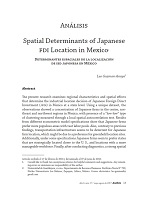Determinantes espaciales en la localización de la IED japonesa en México
DOI:
https://doi.org/10.32870/mycp.v6i17.526Palabras clave:
IED japonesa, factores de localización, análisis espacialResumen
En esta investigación se examinan las características regionales y los efectos espaciales que determinan la localización industrial a nivel estatal de la inver- sión extranjera directa japonesa (IEDJ) en México. Haciendo uso de una base de datos única, se observó una concentración de empresas japonesas en las regiones centro, noreste y noroeste de México, con la presencia de clústeres del tipo “bajo-bajo” medidos por medio de pruebas de autocorrelación espa- cial. Los resultados de diferentes especificaciones econométricas sugieren que firmas niponas prefieren áreas con mayor concentración de población que les da acceso a fuentes de mano de obra. También, contradiciendo resultados previos, la infraestructura del transporte parece disuadir la localización de firmas japonesas, lo que puede significar una preferencia por sitios rurales. Adicionalmente, bajo ciertas especificaciones, empresas japonesas parecen ubicarse en estados que se encuentran estratégicamente más cerca de Estados Unidos y en lugares con una mano de obra más manejable. Finalmente, des- pués de correr diagnósticos, se encontró una fuerte dependencia espacial en los términos de error, lo que significa que la presencia de empresas japonesas está afectando la localización de otras firmas niponas en estados vecinos que se encuentran por arriba de niveles “normales”, o también podría deberse a que el modelo tenga ausente una variable con características espaciales que no se incorporó en las especificaciones.Descargas
Citas
Anselin, L. (1988). Spatial Econometrics: Methods and Models. The Netherlands: Kluwer Academic Publishers.
Aoki, M. (1990). Toward an Economic Model of the Japanese Firm. Journal of Economic Literature, 28(1): 1-27.
Asanuma, B. (1989). Manufacturer-supplier Relationships in Japan and the Concept of Relation Specific Skill. Journal of the Japanese and International Economies, 3(1): 1-30.
Assuncao, S., Forte, R. and Teixeira, A. (2011). Location Determinants of fdi: A Literature Review. Fep Working Papers, No. 433, October.
Belderbos, R. and Carree, M. (2002). The Location of Japanese Investments in China: Agglomeration Effects, Keiretsu and Firm Heterogeneity. Journal of the Japanese and International Economies, 16(2): 194-211. doi: 10.1006/jjie.2001.0491
Blanc-Brude, F., Cookson, G., Piesse, J. and Strange, R. (2014). The fdi Location Decision: Distance and the Effects of Spatial Dependence. International Business Review, 23(4): 797-810.
Cámara Japonesa de Comercio e Industria. (2015). Cámara Japonesa de Comercio e Industria Directorio 2015. México: Cámara Japonesa de Comercio e Industria.
Cassidy, J. F. and Andreosso-O’Callaghan, B. (2006). Spatial Determinants of Japanese fdi in China. Japan and the World Economy, 18(4): 512-527.
Chan, C., Makino, S. and Isobe, T. (2006). Interdependent Behavior in Foreign Direct Investment: The Multi-level Effects of Prior Entry and Prior Exit on Foreign Market Entry. Journal of International Business Studies, 37(5): 642-665.
Cheng, S. and Stough, R. R. (2006). Location Decisions of Japanese New Manufacturing Plants in China: a Discrete-choice Analysis. Annals of Regional Science, 40(2): 369-387. doi: 10.1007/s00168-005-0052-4
Coughlin, C., Terza, J. V. and Arromdee, V. (1991). State Characteristics and the Location of Foreign Direct Investment in the United States. The Review of Economics and Statistics, 73(4): 675-678.
Dunning, J. H. and Lundan, S. M. (2008). Theories of Foreign Direct Investment. In J. H. Dunning and S. M. Lundan (Org.), Multinational Enterprises and the Global Economy (pp. 79-115). Cheltenham: Edward Elgar Publishing Ltd.
Friedman, J., Hung-Gay F., Gerlowski, D. A. and Silberman, J. (1996). A note on “State Characteristics and the Location Choice of Foreign Direct Investment within the United States”. The Review of Economics and Statistics, 78(2): 367-368.
Guimaraes, P., Figueiredo, O. and Woodward, D. (2000). Agglomeration and the location of Foreign Direct Investment in Portugal. Journal of Urban Economics, 47(1): 115-135.
Guzman-Anaya, L. (2013). Are Productivity Spillovers from Japanese fdi Larger than U. S. fdi? Inter-industry Evidence from Mexico. México: Universidad de Guadalajara.
Guzman-Anaya, L. (2015). Localization Factors from Japanese Firms in Automotive-related Industries in Mexico. Procedia Economics and Finance, No. 30, pp. 223-247. doi: 10.1016/S2212-5671(15)01294-0
Head, K. C., Ries, J. C. and Swenson, D. L. (1995). Agglomeration Benefits and Location Choice: Evidence from Japanese Manufacturing Investments in the United States. Journal of International Economics, No. 38, pp. 223-247.
Head, K. C., Ries, J. C. and Swenson, D. L. (1999). Attracting Foreign Manufacturing: Investment Promotion and Agglomeration. Regional Science and Urban Economics, 29(2): 197-218.
Inegi. (2010). Estados Unidos Mexicanos. Censo de Población y Vivienda 2010. México: inegi.
Inegi. (2013). Anuario estadístico y geográfico por entidad federativa 2013. México: inegi.
Jordaan, J. A. (2009). Foreign Direct Investment, Agglomeration and Externalities. England: Ashgate.
Kakihara, T. and Guzman-Anaya, L. (2014). Factores de localización de la inversión extranjera directa japonesa en México. In T. Okabe and S. Carrillo (Eds.), Relaciones México-Japón en el contexto del Acuerdo de Asociación Económica (pp. 135-179). México: Juan Pablos Editor.
Lesage, J. and Pace, K. R. (2009). Introduction to Spatial Econometrics. United States: crc Press.
Luger, M. and Shetty, S. (1985). Determinants of Foreign Plant Start-ups in the United States: Lessons for Policy Makers in the Southeast. Vanderbilt Journal of Transnational Law, No. 18, pp. 223-245.
Mair, A., Florida, R. and Kenney, M. (1988). The New Geography of Automobile Production: Japanese Transplants in North America. Economic Geography, 64(4): 352-373.
Romero, Q. L. and Andrés-Rosales, R. (2014). Técnicas modernas de análisis regional. México: Plaza y Valdés.
Secretaría de Economía. (2015). Estadística oficial de los flujos de ied hacia México. Retrieved from: www.economia.gob.mx/comunidad-negocios/competitividad-normatividad/inversion-extranjera-directa. [Accessed: December 4, 2015].
Secretaría de Economía. (2016). Siem estadísticas por entidad federativa y actividad. Retrieved from: www.economia.gob.mx/comunidad-negocios/competitividadnormatividad/inversion-extranjera-directa. [Accessed: June 20, 2016].
Smith, D. F. and Florida, R. (1994). Agglomeration and Industrial Location: An Econometric Analysis of Japanese-Affiliated Manufacturing Establishments in Automotive-Related Industries. Journal of Urban Economics,36(1): 23-41.
Toyo Keizai. (2014). Kaigai Shinshutsu Kigyou Souran-Kuni Betsu. Tokyo: Toyo Keizai.
Toyo Keizai. (2015). Kaigai Shinshutsu Kigyou Souran-Kuni Betsu. Tokyo: Toyo Keizai.
Wakasugi, R. (2005). The Effects of Chinese Regional Conditions on the Location Choice of Japanese Affiliates. The Japanese Economic Review, 56(4):390-407. doi: 10.1111/j.1468-5876.2005.00337.x
Woodward, D. (1992). Locational Determinants of Japanese Start-ups in the United States. Southern Economic Journal, No. 58, pp. 690-708. doi: 10.2307/1059836
Zaheer, S. (1995). Overcoming the Liability of Foreignness. Academy of Management Journal, 38(2): 341-363. doi: 10.2307/256683
Zhou, C., Delios, A., and Yang J. Y. (2002). Location Determinants of Japanese Foreign Direct Investment in China. Asia Pacific Journal of Management, No. 19, pp. 63-86. doi: 10.1023/A:1014839607180

Descargas
Publicado
Cómo citar
Número
Sección
Licencia
Política de acceso abierto
Esta revista proporciona un acceso abierto a su contenido, fiel al principio de que ofrecer al público un acceso libre a las investigaciones ayuda a un mayor intercambio global del conocimiento.
MyCP se publica bajo la licencia de Creative Commons Reconocimiento-No Comercial CC BY-NC
Los contenidos serán publicados en versión PDF y XML.
Los autores(as) que publiquen en México y la Cuenca del Pacífico aceptan las siguientes condiciones:
De acuerdo con la legislación de derechos de autor, México y la Cuenca del Pacífico reconoce y respeta el derecho moral de los autores(as), así como la titularidad del derecho patrimonial, mismo que será cedido a la Universidad de Guadalajara para su difusión en acceso abierto.
México y la Cuenca del Pacífico no realiza cargos a los autores(as) por enviar y procesar artículos para su publicación.
Los autores(as) pueden realizar otros acuerdos contractuales independientes y adicionales para la distribución no exclusiva de la versión del artículo publicado en México y la Cuenca del Pacífico (por ejemplo, incluirlo en un repositorio institucional o darlo a conocer en otros medios en papel o electrónicos) siempre que indique clara y explícitamente que el trabajo se publicó por primera vez en México y la Cuenca del Pacífico.
Una vez que se acepte el artículo para su publicación los autores(as) deben remitir el formato de carta-cesión de derechos de la publicación debidamente requisitado y firmado por los autores(as). Este formato debe ser remitido en archivo PDF paralelamente con la versión final del artículo al correo: mexicoylacuenca@gmail.com.
Los lectores/usuarios de México y la Cuenca del Pacífico pueden acceder directamente al contenido de manera libre y gratuita en todo momento, incluyendo cuando un nuevo número es colocado en la plataforma. Se permite al lector/usuario citar, compartir (electrónicamente y de manera física), imprimir y distribuir el material siempre que se indique de manera clara y explícitamente que el trabajo se publicó por primera vez en México y la Cuenca del Pacífico. Es necesario citar de manera correcta el trabajo y no debe de ser utilizado con fines comerciales.




